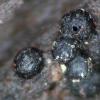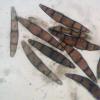
12-09-2013 18:39
 Nicolas VAN VOOREN
Nicolas VAN VOOREN
Bonsoir.Récolté ce matin, en compagnie de Hymeno

12-09-2013 18:53
 Hans-Otto Baral
Hans-Otto Baral
Hi alldoes someone have a pdf ofRaitviir, A. 1998.

10-09-2013 12:38
Alain BRISSARDBonjour à tousPourcette Scutellinie, je fais enco

09-09-2013 23:27
 Martin Bemmann
Martin Bemmann
Dear Friends,a "lichen-colleague" did send me a dr

10-09-2013 00:28
Esquivel-Rios EduardoHola todos.Este hongo lo encontre en un tronco mue
Trematosphaeria hydrela : confirmation
Nicolas VAN VOOREN,
12-09-2013 18:39
 Bonsoir.
Bonsoir.Récolté ce matin, en compagnie de Hymenoscyphus ombrophilaeformis, ce qui me semble être Trematosphaeria hydrela. La clé inédite de Jacques, relative aux aquatiques, m'amène sur ce taxon, de même que l'excellent article de Yannick Mourgues qui vient de paraître dans le bulletin de la FAMM !
Spores à 5-7 cloisons, 81-100 x 15-17 µm, porés aux sommets. Récolté sur bois mort de conifère (Abies probablement), à demi-immergé dans un ruisseau de montagne.
D'avance merci aux aquatophiles pour leur confirmation :)
Jacques Fournier,
12-09-2013 18:49

Re : Trematosphaeria hydrela : confirmation
salut Nico,
tu vois bien que c'est facile les aquatiques!
Jacques
tu vois bien que c'est facile les aquatiques!
Jacques
Nicolas VAN VOOREN,
12-09-2013 19:08

Re : Trematosphaeria hydrela : confirmation
Oui, c'est toujours plus facile quand d'autres ont défriché le terrain.
Amitiés.
Nico
Amitiés.
Nico
Yannick Mourgues,
12-09-2013 19:26

Re : Trematosphaeria hydrela : confirmation
Yes ! Jolie récolte.
Yannick
Yannick

